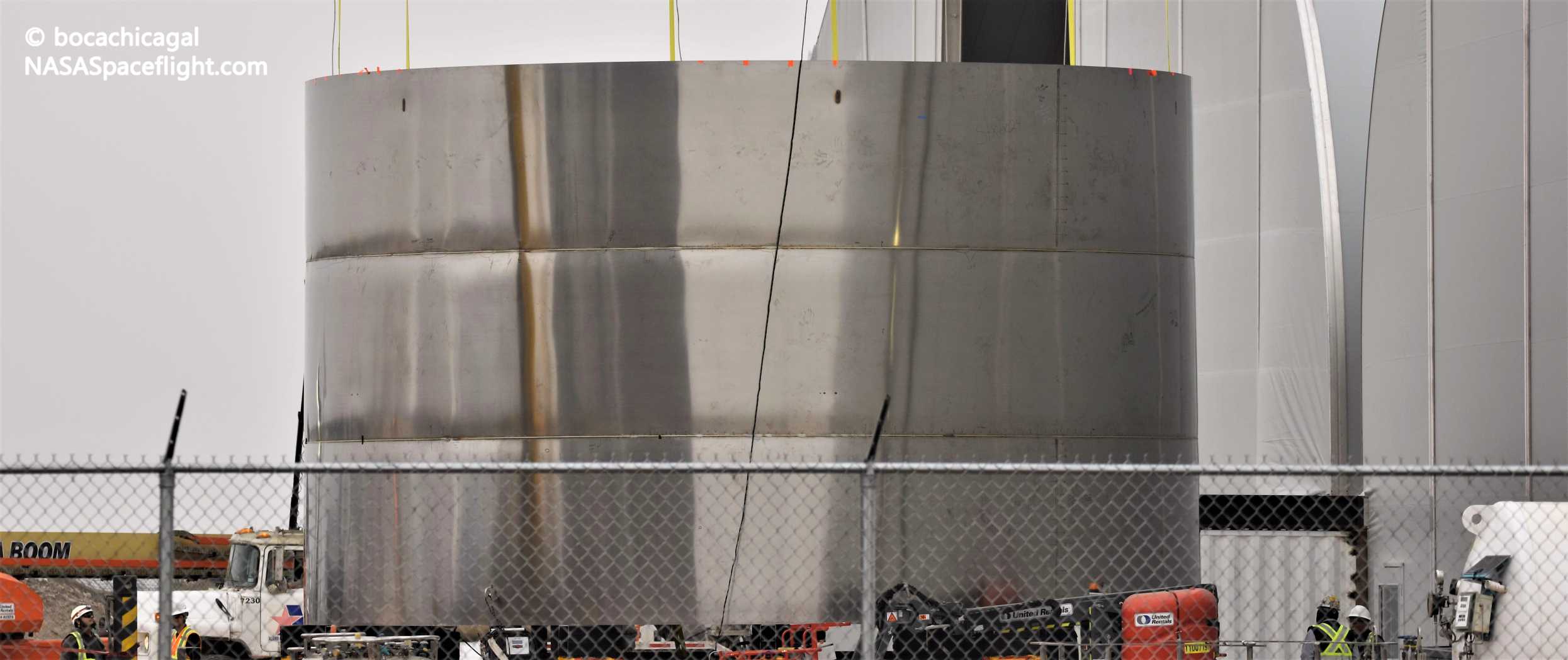
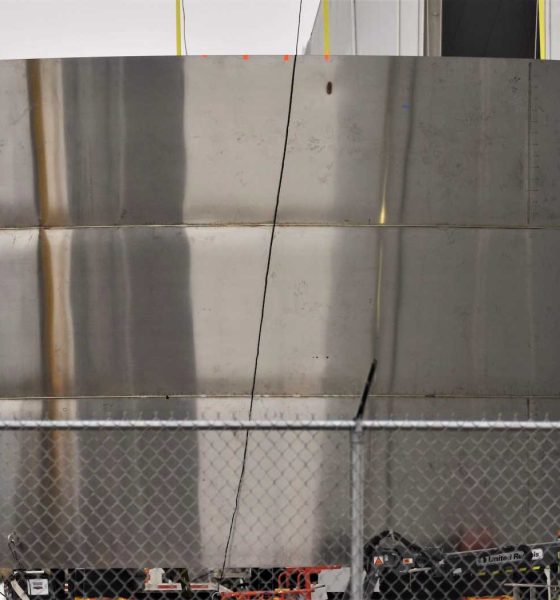
News
SpaceX Starship factory eyes cutting-edge industry solutions for inspiration [updated]
Update: In a Twitter response to this article, SpaceX CEO Elon Musk says that the reality of things is unsurprisingly a bit more complex. As noted, the standards and requirements for aerospace hardware are much stricter than those needed for the water towers, storage tanks, and other utilities that existing commercial solutions are commonly used to build.
As such, it’s inaccurate to suggest that those off-the-shelf solutions are capable of building rockets right out of the box. Still, several pieces of commercial fabrication equipment from providers like IMCAR have been spotted in use at SpaceX’s Boca Chica, Texas Starship facilities. With “substantial capital and engineering” investments into making those solutions more precise, however, SpaceX may still be able to use existing hardware – or at least the concepts they underly – to rapidly build high-quality Starships and Super Heavy boosters.
A SpaceX engineer says that the company wants to adopt commercially-available manufacturing equipment that could allow its Boca Chica, Texas team to build Starship tank parts in minutes and nearly-complete rocket bodies in a matter of days.
Originally created to meet the needs of a variety of different companies – typically oil and gas related – that need efficient, affordable, and standardized storage tanks, a small but growing niche exists for semi-automated tank production. While there is some clear uncertainty given that the quality and consistency required for oil and gas needs or even simple water storage likely isn’t the same needed to meet strict spaceflight margins, SpaceX has already acquired several production tools from existing contractors and is working around the clock to prove that those same tools can be used to build large, reusable rockets.
The gamble is simple: if it turns out that off-the-shelf (COTS) equipment can become an almost turnkey solution for manufacturing high-quality Starship spacecraft and Super Heavy boosters, SpaceX may have found a shortcut to orbit, avoiding the huge expense of finding and building its own custom production solutions. But is that COTS tank fabrication hardware truly up to the task?

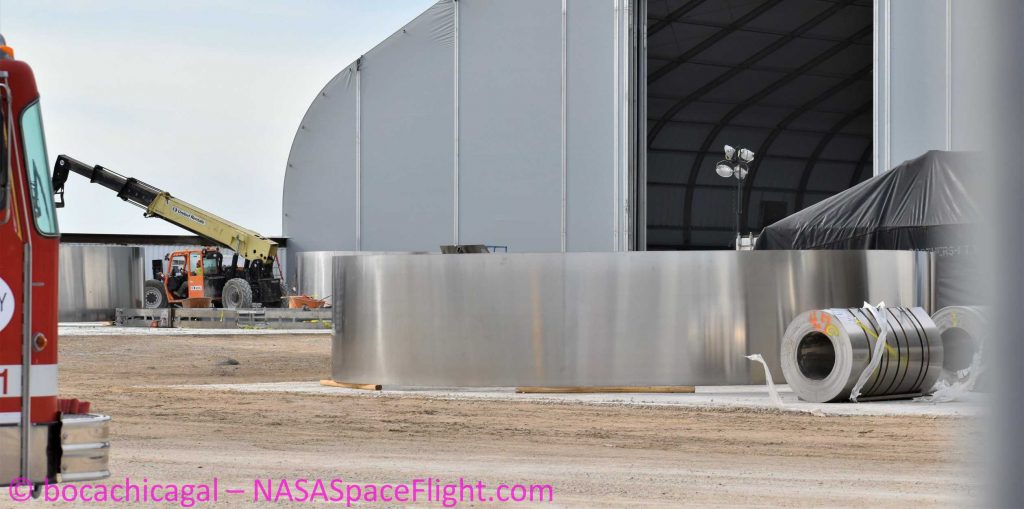
At least right now, the simple answer is “yes”. Thanks to two highly successful destructive tests of Starship tank prototypes that wrapped up last month, SpaceX has confirmed that at least a subset of the available COTS solutions can be used to build Starships (theoretically) capable of orbital flight. To be clear, those tanks reached only the most basic kind of specification needed for a true orbital-class spacecraft, demonstrating that they can fairly easily survive the pressures required for Starship and its Super Heavy boosters to remain structurally sound from liftoff to touchdown.
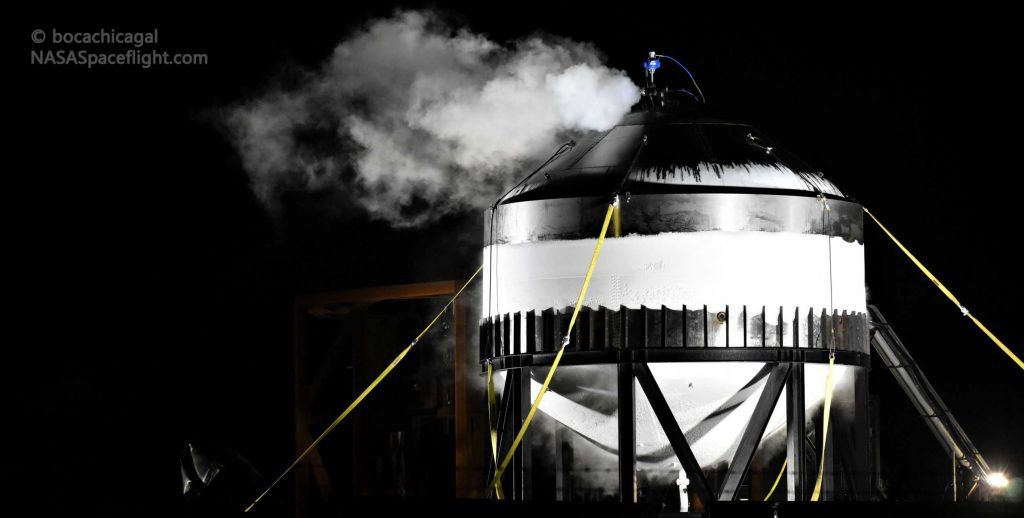
For the most part, the only truly COTS aspect of those test tanks were the flat, cylindrical rings at their center – produced by cutting and welding together giant sheets of coiled steel. The tanks’ domes were more or less welded together by hand with the help of large jigs, while finished domes and rings were also welded together by hand. Given that the welds used to create the rings themselves have never obviously been a problem, the success of Starship’s two test tanks can thus be heavily attributed to skilled welders’ hands rather than any particular off-the-shelf solution.
Still, the fact of the matter is that automatic solutions like those currently available exist for good reason – aside from requiring far less labor to produce similar results, the consistency and quality of those results can actually be much better than anything that can be reliably achieved in a more boutique fashion. This is, at least, the promise of solutions like those shown below.
SpaceX certainly appears to be pursuing the best-case scenarios that could be made possible with some of the hardware shown above. Already, it looks like Starship ring segments – themselves formed and welded with semi-automated IMCAR hardware – are being stacked and tack welded (temporary welds used like clamps) inside one of SpaceX’s new tents before the stand holding those ring(s) rotates itself, automatically welding them together.
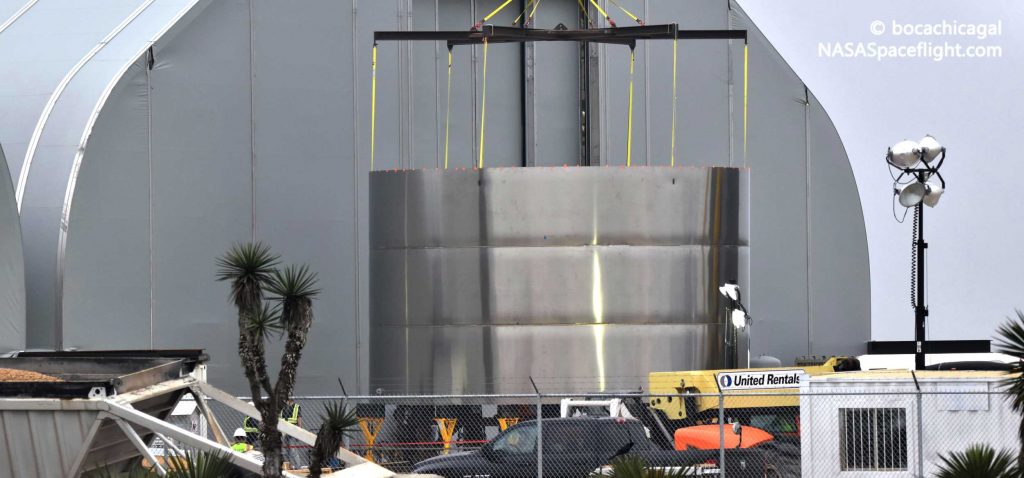
The three mated rings pictured above were assembled over the course of several days using some of those methods and COTS fabrication hardware. However, if SpaceX can refine its procedures – currently still in the oven, so to speak – and become an expert at modifying and using available tank fabrication hardware to fabricate rockets, the company could conceivably build entire Starship and Super Heavy bodies in a matter of days.
It might take a substantial amount of trial and error, but SpaceX is clearly well on its way.
Check out Teslarati’s Marketplace! We offer Tesla accessories, including for the Tesla Cybertruck and Tesla Model 3.

Cybertruck
Tesla updates Cybertruck owners about key Powershare feature

Tesla is updating Cybertruck owners on its timeline of a massive feature that has yet to ship: Powershare with Powerwall.
Powershare is a bidirectional charging feature exclusive to Cybertruck, which allows the vehicle’s battery to act as a portable power source for homes, appliances, tools, other EVs, and more. It was announced in late 2023 as part of Tesla’s push into vehicle-to-everything energy sharing, and acting as a giant portable charger is the main advantage, as it can provide backup power during outages.
Cybertruck’s Powershare system supports both vehicle-to-load (V2L) and vehicle-to-home (V2H), making it flexible and well-rounded for a variety of applications.
However, even though the feature was promised with Cybertruck, it has yet to be shipped to vehicles. Tesla communicated with owners through email recently regarding Powershare with Powerwall, which essentially has the pickup act as an extended battery.
Powerwall discharge would be prioritized before tapping into the truck’s larger pack.
However, Tesla is still working on getting the feature out to owners, an email said:
“We’re writing to let you know that the Powershare with Powerwall feature is still in development and is now scheduled for release in mid-2026.
This new release date gives us additional time to design and test this feature, ensuring its ability to communicate and optimize energy sharing between your vehicle and many configurations and generations of Powerwall. We are also using this time to develop additional Powershare features that will help us continue to accelerate the world’s transition to sustainable energy.”
Owners have expressed some real disappointment in Tesla’s continuous delays in releasing the feature, as it was expected to be released by late 2024, but now has been pushed back several times to mid-2026, according to the email.
Foundation Series Cybertruck buyers paid extra, expecting the feature to be rolled out with their vehicle upon pickup.
Cybertruck’s Lead Engineer, Wes Morrill, even commented on the holdup:
As a Cybertruck owner who also has Powerwall, I empathize with the disappointed comments.
To their credit, the team has delivered powershare functionality to Cybertruck customers who otherwise have no backup with development of the powershare gateway. As well as those with solar…
— Wes (@wmorrill3) December 12, 2025
He said that “it turned out to be much harder than anticipated to make powershare work seamlessly with existing Powerwalls through existing wall connectors. Two grid-forming devices need to negotiate who will form and who will follow, depending on the state of charge of each, and they need to do this without a network and through multiple generations of hardware, and test and validate this process through rigorous certifications to ensure grid safety.”
It’s nice to see the transparency, but it is justified for some Cybertruck owners to feel like they’ve been bait-and-switched.
News
Tesla’s northernmost Supercharger in North America opens

Tesla has opened its northernmost Supercharger in Fairbanks, Alaska, with eight V4 stalls located in one of the most frigid cities in the U.S.
Located just 196 miles from the Arctic Circle, Fairbanks’s average temperature for the week was around -12 degrees Fahrenheit. However, there are plenty of Tesla owners in Alaska who have been waiting for more charging options out in public.
There are only 36 total Supercharger stalls in Alaska, despite being the largest state in the U.S.
Eight Superchargers were added to Fairbanks, which will eventually be a 48-stall station. Tesla announced its activation today:
North America’s northernmost Supercharger Fairbanks, AK (8 stalls) opened to public. https://t.co/M4l04DZ6B5 pic.twitter.com/zyL6bDuA93
— Tesla Charging (@TeslaCharging) December 12, 2025
The base price per kWh is $0.43 at the Fairbanks Supercharger. Thanks to its V4 capabilities, it can charge at speeds up to 325 kW.
Despite being the northernmost Supercharger in North America, it is not even in the Top 5 northernmost Superchargers globally, because Alaska is south of Norway. The northernmost Supercharger is in Honningsvåg, Norway. All of the Top 5 are in the Scandanavian country.
Tesla’s Supercharger expansion in 2025 has been impressive, and although it experienced some early-quarter slowdowns due to V3-to-V4 hardware transitions, it has been the company’s strongest year for deployments.
🚨🚨 Tesla Supercharging had a HUGE year, and they deserve to be recognized.
🍔 Opened Tesla Diner, a drive-in movie theater with awesome, Chef-curated cuisine
🔌 Gave access to Superchargers to several EV makers, including Hyundai, Genesis, Mercedes-Benz, Kia, Lucid, Toyota,… pic.twitter.com/yYT2QEbqoW
— TESLARATI (@Teslarati) December 10, 2025
Through the three quarters of 2025, the company has added 7,753 stations and 73,817 stalls across the world, a 16 percent increase in stations and an 18 percent increase in stalls compared to last year.
Tesla is on track to add over 12,000 stalls for the full year, achieving an average of one new stall every hour, an impressive statistic.
Recently, the company wrapped up construction at its Supercharger Oasis in Lost Hills, California, a 168-stall Supercharger that Tesla Solar Panels completely power. It is the largest Supercharger in the world.
News
Tesla shocks with latest Robotaxi testing move
Why Tesla has chosen to use a couple of Model S units must have a reason; the company is calculated in its engineering and data collection efforts, so this is definitely more than “we just felt like giving our drivers a change of scenery.”

Tesla Model S vehicles were spotted performing validation testing with LiDAR rigs in California today, a pretty big switch-up compared to what we are used to seeing on the roads.
Tesla utilizes the Model Y crossover for its Robotaxi fleet. It is adequately sized, the most popular vehicle in its lineup, and is suitable for a wide variety of applications. It provides enough luxury for a single rider, but enough room for several passengers, if needed.
However, the testing has seemingly expanded to one of Tesla’s premium flagship offerings, as the Model S was spotted with the validation equipment that is seen entirely with Model Y vehicles. We have written several articles on Robotaxi testing mules being spotted across the United States, but this is a first:
🚨 Tesla is using Model S vehicles fitted with LiDAR rigs to validate FSD and Robotaxi, differing from the Model Ys that it uses typically
Those Model Y vehicles have been on the East Coast for some time. These Model S cars were spotted in California https://t.co/CN9Bw5Wma8 pic.twitter.com/UE55hx5mdd
— TESLARATI (@Teslarati) December 11, 2025
Why Tesla has chosen to use a couple of Model S units must have a reason; the company is calculated in its engineering and data collection efforts, so this is definitely more than “we just felt like giving our drivers a change of scenery.”
It seems to hint that Tesla could add a premium, more luxury offering to its Robotaxi platform eventually. Think about it: Uber has Uber Black, Lyft has Lyft Black. These vehicles and services are associated with a more premium cost as they combine luxury models with more catered transportation options.
Tesla could be testing the waters here, and it could be thinking of adding the Model S to its fleet of ride-hailing vehicles.
Reluctant to remove the Model S from its production plans completely despite its low volume contributions to the overall mission of transitioning the world to sustainable energy, the flagship sedan has always meant something. CEO Elon Musk referred to it, along with its sibling Model X, as continuing on production lines due to “sentimental reasons.”
However, its purpose might have been expanded to justify keeping it around, and why not? It is a cozy, premium offering, and it would be great for those who want a little more luxury and are willing to pay a few extra dollars.
Of course, none of this is even close to confirmed. However, it is reasonable to speculate that the Model S could be a potential addition to the Robotaxi fleet. It’s capable of all the same things the Model Y is, but with more luxuriousness, and it could be the perfect addition to the futuristic fleet.








